Cloud-Based Services: Threatening Old Business Model
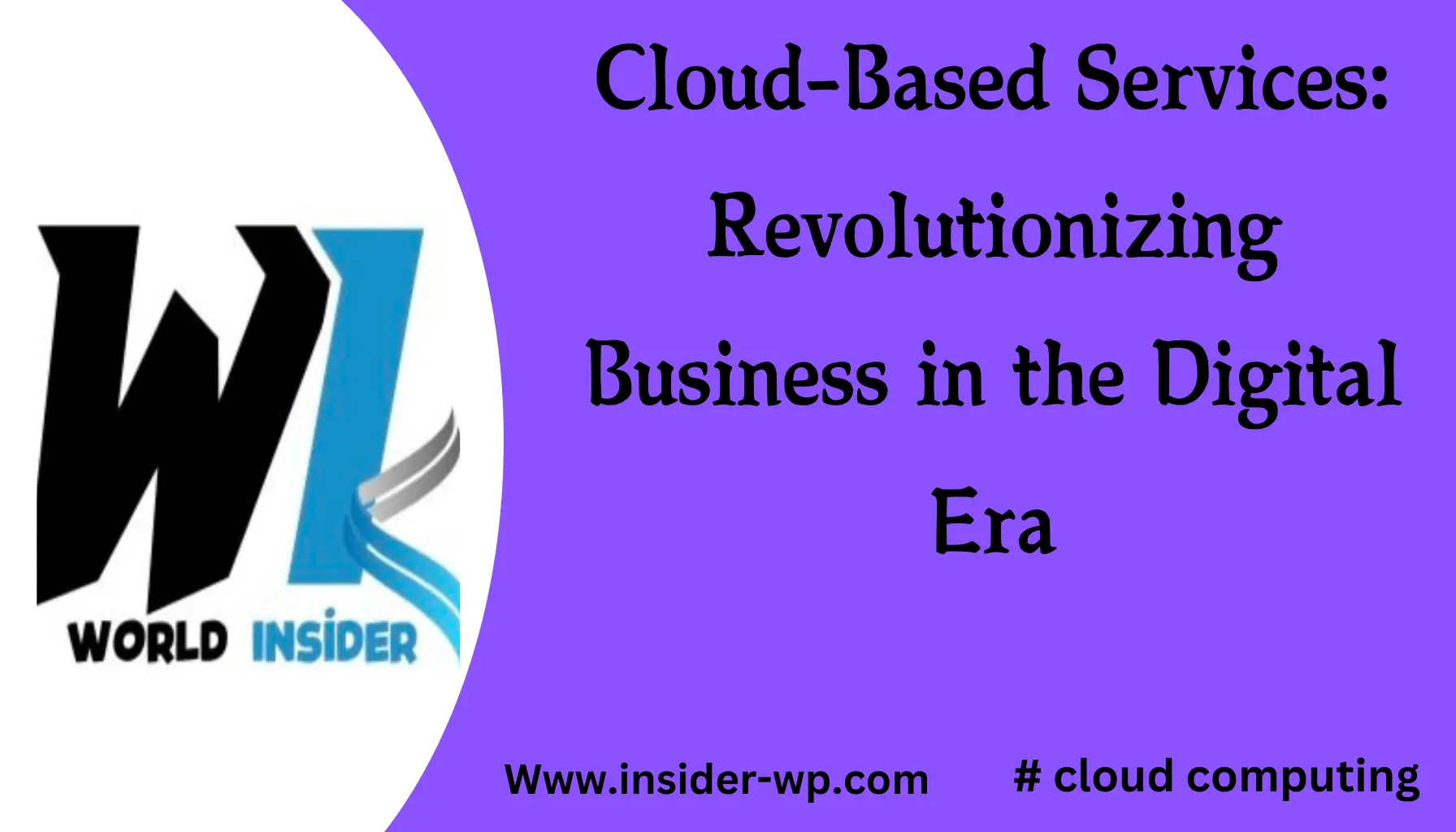
In today’s rapidly evolving digital landscape, cloud-based services have emerged as a game-changing technology, transforming the way businesses operate and scale. From startups to multinational corporations, organizations across industries are leveraging the power of the cloud to drive innovation, enhance efficiency, and stay competitive in an increasingly connected world.
Cloud-based services, at their core, refer to the delivery of computing resources, applications, and data storage over the internet. This revolutionary approach has reshaped traditional IT infrastructure, offering unprecedented flexibility, scalability, and cost-effectiveness. As we delve into the world of cloud computing, we’ll explore its history, current state, and the profound impact it continues to have on businesses worldwide.
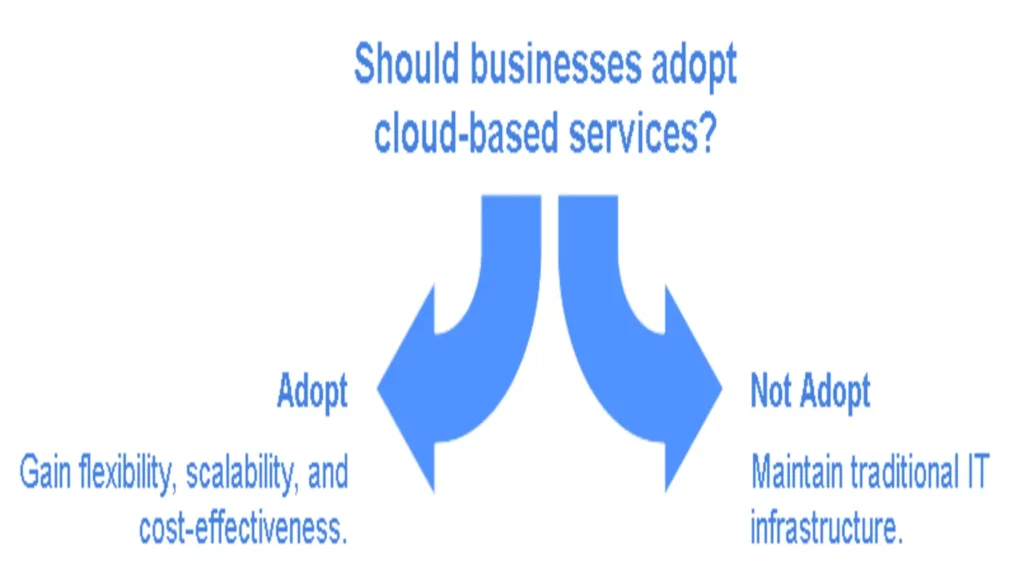
The journey of cloud-based services began in the 1960s with the concept of time-sharing, but it wasn’t until the late 1990s and early 2000s that the modern cloud computing era truly took shape. Pioneering companies like Amazon Web Services (AWS), Google, and Salesforce paved the way for the cloud revolution we see today. According to Gartner, the global public cloud services market is projected to grow 18.4% in 2024, reaching a staggering $678.8 billion.
As we embark on this comprehensive exploration of cloud-based services, we’ll uncover the key components, benefits, and challenges that define this transformative technology. From understanding the different types of cloud services to implementing effective strategies for cloud adoption, this guide will equip you with the knowledge to navigate the ever-expanding cloud landscape.
Timeline of Cloud Computing Evolution
Time-sharing concept emerges
The idea of shared computing resources takes shape.
Salesforce pioneers SaaS
Salesforce.com launches, introducing the concept of delivering enterprise applications via a simple website.
Amazon Web Services (AWS) launches
AWS introduces its cloud computing infrastructure services, marking a significant milestone in cloud technology.
Google App Engine debuts
Google enters the cloud market with its Platform as a Service offering.
Microsoft Azure becomes commercially available
Microsoft joins the cloud race, offering a wide range of cloud services.
Cloud adoption accelerates
The COVID-19 pandemic drives rapid cloud adoption across industries, solidifying its role in modern business operations.
As we can see from this timeline, cloud-based services have come a long way in a relatively short period. The rapid evolution and adoption of cloud technologies underscore their importance in today’s digital-first world. In the following sections, we’ll dive deeper into the intricacies of cloud-based services, exploring their types, benefits, and the transformative impact they continue to have on businesses across the globe.
Understanding Cloud-Based Services
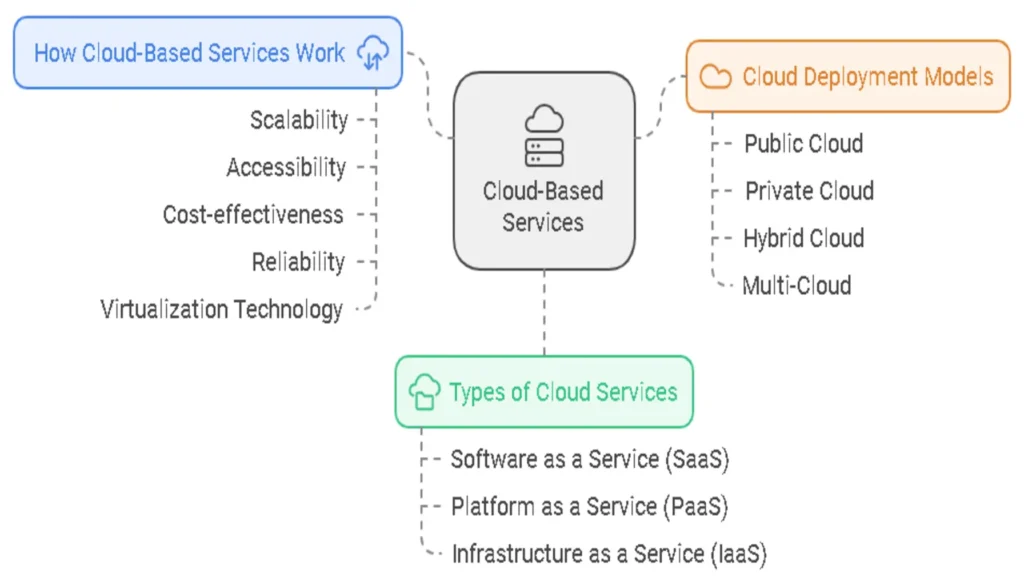
To fully grasp the transformative power of cloud-based services, it’s essential to understand how they work, the different types available, and the various deployment models. This comprehensive overview will provide you with a solid foundation for making informed decisions about cloud adoption and utilization in your business.
How Cloud-Based Services Work
At its core, cloud computing leverages a network of remote servers hosted on the internet to store, manage, and process data, rather than relying on a local server or personal computer. This distributed approach offers several key advantages:
- Scalability: Cloud resources can be easily scaled up or down based on demand.
- Accessibility: Data and applications can be accessed from anywhere with an internet connection.
- Cost-effectiveness: Pay-as-you-go models reduce upfront infrastructure costs.
- Reliability: Redundancy and distributed systems ensure high availability.
The foundation of cloud-based services lies in virtualization technology, which allows multiple virtual servers to run on a single physical machine. This enables efficient resource allocation and maximizes hardware utilization.
Cloud-Based Services Architecture
User Devices
Various devices (computers, smartphones, tablets) connect to cloud services through web browsers or dedicated applications.
Internet
The internet serves as the medium for data transmission between user devices and cloud infrastructure.
Cloud Infrastructure
Consists of data centers housing servers, storage systems, and networking equipment that power cloud-based services.
Types of Cloud Services
Cloud-based services are typically categorized into three main types, often referred to as the “cloud computing stack” due to their built-on-top-of-each-other nature.
Software as a Service (SaaS)
SaaS delivers software applications over the internet, eliminating the need for installation and maintenance on individual devices.
Key Features:
- Accessible via web browsers
- Automatic updates and patch management
- Pay-per-use or subscription-based pricing
Examples: Google Workspace, Salesforce, Microsoft 365
Platform as a Service (PaaS)
PaaS provides a platform allowing customers to develop, run, and manage applications without the complexity of maintaining the underlying infrastructure.
Key Features:
- Development tools, database management, and business analytics
- Scalable and easily manageable
- Reduces coding time and enhances developer productivity
Examples: Google App Engine, Heroku, Microsoft Azure App Service
Infrastructure as a Service (IaaS)
IaaS offers virtualized computing resources over the internet, providing fundamental compute, network, and storage resources on-demand.
Key Features:
- Highly flexible and scalable
- Pay-as-you-go pricing model
- Complete control over infrastructure
Examples: Amazon Web Services (AWS) EC2, Google Compute Engine, DigitalOcean
To better understand the differences between these service types, let’s look at a comparison table:
| Feature | SaaS | PaaS | IaaS |
| Primary Use | End-user applications | Application development and deployment | Virtual IT infrastructure |
| Control Level | Low | Medium | High |
| Customization | Limited | Moderate | Extensive |
| Scalability | Vendor-managed | Easy to scale | Highly scalable |
| Examples | Dropbox, Slack | Heroku, Google App Engine | AWS EC2, Azure Virtual Machines |
Cloud Deployment Models
Cloud services can be deployed in various ways, depending on the specific needs and requirements of an organization. The four main deployment models are:
Public Cloud
Public clouds are owned and operated by third-party cloud service providers, delivering computing resources over the internet.
Advantages:
- Cost-effective
- Highly scalable
- Low maintenance
Disadvantages:
- Potential security concerns
- Limited customization
Examples: Amazon Web Services (AWS), Microsoft Azure, Google Cloud Platform
Private Cloud
Private clouds are dedicated to a single organization, offering enhanced control and privacy.
Advantages:
- Increased security and privacy
- Customizable to organizational needs
- Compliance with industry regulations
Disadvantages:
- Higher upfront costs
- Requires internal expertise to manage
Examples: VMware vSphere, OpenStack, Microsoft Azure Stack
Hybrid Cloud
Hybrid clouds combine public and private clouds, allowing data and applications to be shared between them.
Advantages:
- Flexibility to run workloads in the most appropriate environment
- Cost-effective balance of security and scalability
- Improved disaster recovery capabilities
Disadvantages:
- Complexity in managing multiple environments
- Potential integration challenges
Examples: AWS Outposts, Azure Arc, Google Anthos
Multi-Cloud
Multi-cloud strategies involve using multiple cloud computing and storage services from different vendors in a single heterogeneous architecture.
Advantages:
- Avoid vendor lock-in
- Leverage best-of-breed services from different providers
- Enhanced redundancy and fault tolerance
Disadvantages:
- Increased management complexity
- Potential data integration challenges
Examples: Organizations using a combination of AWS, Azure, and Google Cloud services
To help visualize the differences between these deployment models, consider the following illustration:
Cloud Deployment Models
Public Cloud
Private Cloud
Hybrid Cloud
Multi-Cloud
Understanding these fundamental aspects of cloud-based services is crucial for making informed decisions about cloud adoption and utilization. As we move forward, we’ll explore the specific benefits these services offer to businesses and delve into the challenges and considerations of implementing cloud solutions.
For more in-depth information on cloud service types and deployment models, you can refer to the National Institute of Standards and Technology (NIST) definition of cloud computing.
The Big Three Cloud Service Providers
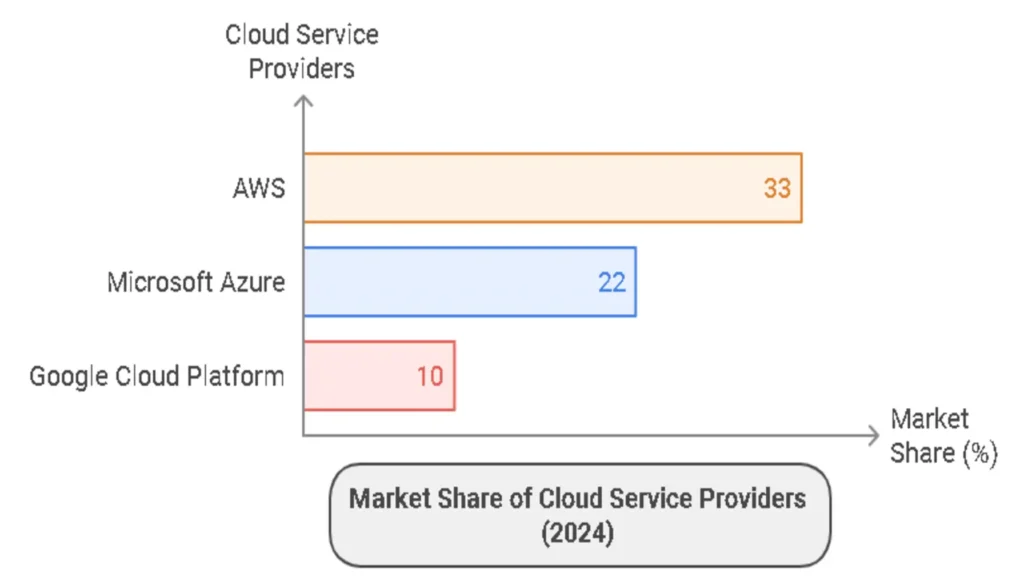
In the rapidly evolving landscape of cloud-based services, three major players have emerged as the dominant forces: Amazon Web Services (AWS), Microsoft Azure, and Google Cloud Platform (GCP). These industry giants, often referred to as the “Big Three,” have shaped the cloud computing market and continue to drive innovation in the field. Let’s take a closer look at each of these providers and their unique offerings.
Amazon Web Services (AWS)
Amazon Web Services, launched in 2006, is widely recognized as the pioneer and leader in the cloud computing industry. With a market share of around 33% as of 2024, AWS offers a comprehensive suite of cloud services that cater to businesses of all sizes and industries.
Key Features of AWS:
- Extensive Global Infrastructure: AWS boasts a vast network of data centers across 31 geographic regions and 99 availability zones, ensuring low-latency access and high availability for users worldwide.
- Comprehensive Service Portfolio: With over 200 fully featured services, AWS covers everything from compute and storage to machine learning and IoT.
- Scalability and Flexibility: AWS’s pay-as-you-go model and auto-scaling capabilities allow businesses to easily adjust their resources based on demand.
- Strong Security and Compliance: AWS offers robust security features and compliance certifications, making it suitable for industries with strict regulatory requirements.
- Ecosystem and Marketplace: The AWS Marketplace provides a wide range of third-party software and services, enhancing the platform’s versatility.
Popular AWS Services:
- Amazon EC2 (Elastic Compute Cloud)
- Amazon S3 (Simple Storage Service)
- Amazon RDS (Relational Database Service)
- AWS Lambda (Serverless Computing)
- Amazon CloudFront (Content Delivery Network)
Microsoft Azure
Microsoft Azure, launched in 2010, has quickly grown to become the second-largest cloud service provider, with a market share of approximately 22% as of 2024. Azure’s strength lies in its seamless integration with Microsoft’s existing enterprise software ecosystem and its hybrid cloud capabilities.
Key Features of Microsoft Azure:
- Hybrid Cloud Expertise: Azure excels in hybrid cloud deployments, allowing businesses to seamlessly integrate on-premises infrastructure with cloud resources.
- Strong Enterprise Integration: Azure’s deep integration with Microsoft products like Office 365 and Dynamics 365 makes it an attractive option for businesses already invested in the Microsoft ecosystem.
- AI and Machine Learning Focus: Azure offers advanced AI and machine learning services, including Azure Cognitive Services and Azure Machine Learning Studio.
- Compliance and Data Residency: Azure provides a wide range of compliance offerings and allows customers to specify data storage locations, addressing data sovereignty concerns.
- DevOps and Container Support: Azure DevOps and Azure Kubernetes Service (AKS) provide robust tools for software development and containerization.
Popular Azure Services:
- Azure Virtual Machines
- Azure Blob Storage
- Azure SQL Database
- Azure Active Directory
- Azure Functions (Serverless Computing)
Google Cloud Platform (GCP)
Google Cloud Platform, while the youngest of the Big Three, has rapidly gained market share and now holds approximately 10% of the market as of 2024. GCP leverages Google’s expertise in data analytics, machine learning, and global network infrastructure to provide cutting-edge cloud services.
Key Features of Google Cloud Platform:
- Data Analytics Prowess: GCP offers powerful data analytics tools like BigQuery, which can process massive datasets in seconds.
- Machine Learning and AI: With services like TensorFlow and Google Cloud AI, GCP provides state-of-the-art machine learning capabilities.
- Global Network Infrastructure: GCP’s network is built on Google’s global infrastructure, ensuring fast and reliable connections worldwide.
- Kubernetes Expertise: As the original creators of Kubernetes, Google offers superior container orchestration capabilities through Google Kubernetes Engine (GKE).
- Commitment to Open Source: GCP strongly supports open-source technologies, making it attractive to developers and organizations invested in open-source solutions.
Popular GCP Services:
- Google Compute Engine
- Google Cloud Storage
- BigQuery
- Google Kubernetes Engine (GKE)
- Google Cloud AI Platform
To better understand the market positioning of these cloud giants, let’s take a look at their market share and key differentiators:
While these three providers dominate the cloud services market, each has its unique strengths and focus areas. AWS leads with its vast service portfolio and global reach, Azure excels in enterprise integration and hybrid cloud solutions, and GCP stands out with its data analytics and machine learning capabilities.
When choosing a cloud service provider, businesses should consider factors such as:
- Specific service requirements
- Pricing and cost management
- Geographic availability
- Compliance and security needs
- Integration with existing systems
- Support and documentation
- Long-term scalability and flexibility
It’s worth noting that many organizations are adopting a multi-cloud strategy, leveraging the strengths of different providers to optimize their cloud infrastructure. According to a recent study by Flexera, 89% of organizations have a multi-cloud strategy, highlighting the importance of understanding the nuances of each provider.
As cloud-based services continue to evolve, these three giants will undoubtedly play a crucial role in shaping the future of cloud computing. Their ongoing competition drives innovation, leading to more advanced, efficient, and cost-effective cloud solutions for businesses worldwide.
Benefits of Cloud-Based Services
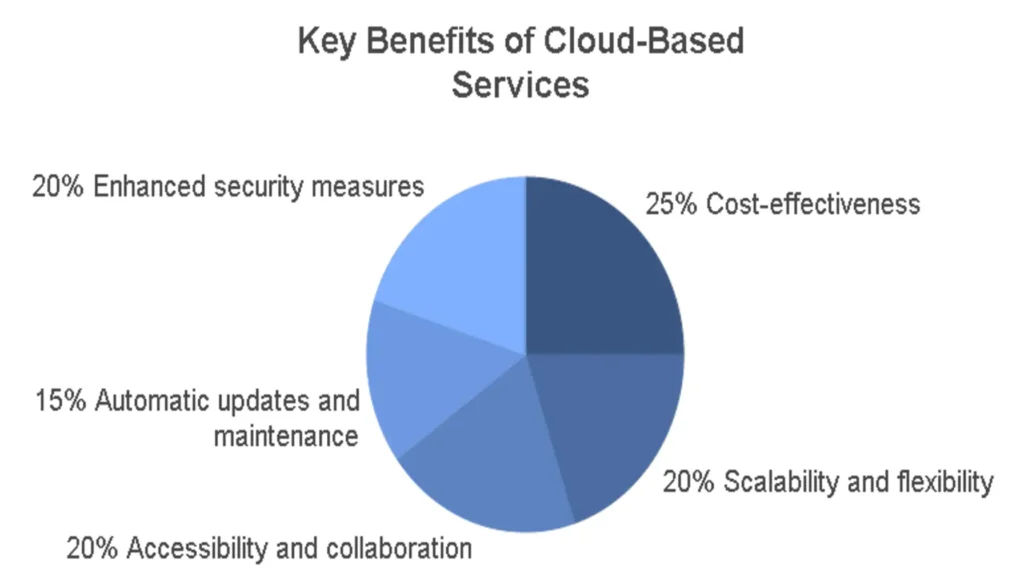
Cloud-based services have revolutionized the way businesses operate, offering a plethora of advantages that drive efficiency, innovation, and growth. In this section, we’ll explore the key benefits that make cloud computing an indispensable tool for modern enterprises.
Cost-effectiveness
One of the most compelling reasons for adopting cloud-based services is the significant cost savings they offer. Traditional on-premises infrastructure requires substantial upfront investments in hardware, software licenses, and IT personnel. Cloud computing eliminates or reduces many of these expenses, providing a more economical alternative.
Key cost-saving aspects of cloud-based services:
- Reduced capital expenditure: With cloud services, businesses can shift from capital expenses (CapEx) to operational expenses (OpEx), freeing up resources for other strategic investments.
- Pay-as-you-go model: Most cloud providers offer flexible pricing models, allowing businesses to pay only for the resources they use.
- Economies of scale: Cloud providers can offer lower prices due to their large-scale operations and shared resources across multiple clients.
- Lower energy costs: By outsourcing data center operations to cloud providers, businesses can significantly reduce their energy consumption and associated costs.
- Reduced IT staff requirements: Cloud services often come with managed support, reducing the need for extensive in-house IT teams.
A study by Rackspace found that 88% of cloud users experienced cost savings, with 56% noting that cloud services helped them boost profits.
Cloud Cost Savings Calculator
Scalability and flexibility
Cloud-based services offer unparalleled scalability and flexibility, allowing businesses to adapt quickly to changing market demands and operational needs.
Key scalability and flexibility benefits:
- On-demand resource allocation: Easily scale up or down computing resources based on current needs.
- Rapid deployment: Launch new applications or services in minutes rather than weeks or months.
- Global reach: Access cloud resources from anywhere in the world, facilitating business expansion.
- Multi-cloud and hybrid cloud options: Combine different cloud services or integrate with on-premises infrastructure for optimal performance.
- Automatic load balancing: Efficiently distribute workloads across multiple servers to ensure optimal performance.
According to a report by Flexera, 59% of enterprises expect cloud usage to exceed prior plans due to COVID-19, highlighting the importance of scalability in uncertain times.
Accessibility and collaboration
Cloud-based services have redefined how teams work together, breaking down geographical barriers and enabling seamless collaboration.
Key accessibility and collaboration features:
- Remote work enablement: Access work resources from anywhere with an internet connection.
- Real-time collaboration: Multiple team members can work on the same document or project simultaneously.
- Cross-device compatibility: Access cloud services from various devices, including smartphones, tablets, and laptops.
- Centralized data storage: Store all important files and data in one secure, accessible location.
- Improved communication: Integrate cloud-based communication tools for better team coordination.
A study by McKinsey found that cloud-based collaboration tools can improve productivity by 20-30%.
Automatic updates and maintenance
Cloud service providers handle most of the maintenance and updates, freeing up IT teams to focus on more strategic initiatives.
Benefits of automatic updates and maintenance:
- Always up-to-date software: Access the latest features and security patches without manual intervention.
- Reduced downtime: Cloud providers typically offer high availability and redundancy.
- Predictive maintenance: Advanced analytics help prevent issues before they occur.
- Simplified compliance: Many cloud providers offer compliance-ready solutions, easing the burden on businesses.
- Continuous innovation: Benefit from ongoing improvements and new features rolled out by cloud providers.
Enhanced security measures
Contrary to initial concerns, cloud-based services often provide superior security compared to on-premises solutions.
Key security features of cloud-based services:
- Advanced encryption: Data is encrypted both in transit and at rest.
- Regular security audits: Cloud providers undergo frequent security assessments and certifications.
- Multi-factor authentication: Enhanced access controls to prevent unauthorized access.
- Automated backups and disaster recovery: Ensure business continuity in case of data loss or system failures.
- 24/7 monitoring: Dedicated security teams constantly monitor for threats and vulnerabilities.
According to a report by Nominet, 61% of security professionals believe cloud environments are as secure as or more secure than on-premises environments.
Cloud vs. On-Premises Security Comparison
| Security Aspect | Cloud-Based Services | On-Premises Solutions |
|---|---|---|
| Data Encryption | Advanced encryption in transit and at rest | Varies based on implemented solutions |
| Security Updates | Automatic and frequent | Manual and potentially delayed |
| Access Control | Multi-factor authentication, granular permissions | Depends on implemented systems |
| Monitoring | 24/7 by dedicated security teams | Limited by in-house resources |
| Compliance | Often comes with compliance-ready solutions | Requires significant effort to maintain compliance |
In conclusion, the benefits of cloud-based services extend far beyond mere cost savings. They provide businesses with the agility, scalability, and security needed to thrive in today’s fast-paced digital environment. As cloud technologies continue to evolve, organizations that embrace these services position themselves at the forefront of innovation and competitive advantage.
Popular Cloud-Based Services and Their Applications
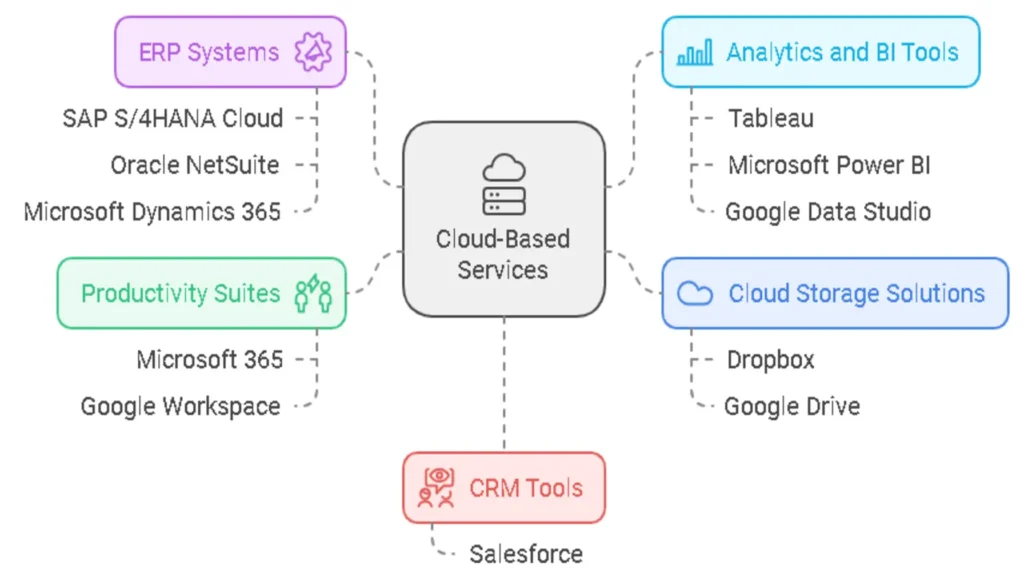
The versatility of cloud-based services has led to their widespread adoption across various business functions. From storing and sharing files to managing complex business processes, cloud solutions have become integral to modern organizations. Let’s explore some of the most popular cloud-based services and their applications:
Cloud Storage Solutions
Cloud storage has revolutionized the way we store, access, and share data. These services provide users with secure, scalable, and easily accessible storage options. Two prominent examples are:
- Dropbox:
- Founded in 2007, Dropbox has become synonymous with cloud storage.
- Offers file synchronization, sharing, and collaboration features.
- Provides both personal and business plans.
- Google Drive:
- Launched in 2012 as part of Google’s ecosystem.
- Integrates seamlessly with other Google services like Docs, Sheets, and Slides.
- Offers generous free storage and affordable paid plans.
Cloud Storage Comparison
| Feature | Dropbox | Google Drive |
|---|---|---|
| Free Storage | 2 GB | 15 GB |
| File Sharing | Yes | Yes |
| Collaboration Tools | Yes (Dropbox Paper) | Yes (Google Docs, Sheets, Slides) |
| Version History | Yes (30 days for free, 180 days for paid) | Yes (30 days, unlimited for Google Workspace) |
Productivity Suites
Cloud-based productivity suites have transformed how teams collaborate and work together. These comprehensive platforms offer a range of tools for document creation, communication, and project management. Two leading examples are:
- Microsoft 365 (formerly Office 365):
- Includes cloud versions of popular Microsoft applications like Word, Excel, and PowerPoint.
- Offers robust email and calendar services through Outlook.
- Provides team collaboration tools like Microsoft Teams.
- Google Workspace (formerly G Suite):
- Features a suite of productivity tools including Docs, Sheets, and Slides.
- Offers Gmail for business email hosting.
- Includes Google Meet for video conferencing and Google Chat for team messaging.
Both these suites have seen rapid adoption, especially in the wake of the COVID-19 pandemic. According to a report by Okta, Microsoft 365 and Google Workspace were the top two most popular apps among their customers in 2021.
Customer Relationship Management (CRM) Tools
CRM tools have become essential for businesses looking to manage their customer interactions effectively. These cloud-based solutions offer a centralized platform for sales, marketing, and customer service functions. A prime example is:
Salesforce:
- Founded in 1999, Salesforce pioneered the Software-as-a-Service (SaaS) model.
- Offers a comprehensive suite of CRM tools for sales, marketing, and customer service.
- Provides industry-specific solutions and a robust app marketplace.
Salesforce has maintained its leadership position in the CRM market, with a 19.5% market share in 2020, according to Gartner.
Enterprise Resource Planning (ERP) Systems
Cloud-based ERP systems integrate various business processes into a single, comprehensive platform. These solutions help organizations streamline operations, improve efficiency, and gain better insights into their business. Some popular cloud ERP providers include:
- SAP S/4HANA Cloud
- Oracle NetSuite
- Microsoft Dynamics 365
The cloud ERP market is experiencing significant growth, with a projected CAGR of 13.6% from 2021 to 2028.
Cloud-Based Analytics and Business Intelligence
As data becomes increasingly crucial for decision-making, cloud-based analytics and business intelligence tools have gained prominence. These services allow organizations to process, analyze, and visualize large datasets efficiently. Some leading platforms include:
- Tableau:
- Offers powerful data visualization and analytics capabilities.
- Provides both cloud and on-premises deployment options.
- Microsoft Power BI:
- Integrates seamlessly with other Microsoft products.
- Offers robust data modeling and visualization features.
- Google Data Studio:
- Provides free, user-friendly data visualization and reporting tools.
- Integrates well with Google’s ecosystem of products.
The adoption of these cloud-based services continues to grow as businesses recognize their potential to drive efficiency, collaboration, and data-driven decision-making. According to a survey by Flexera, 93% of enterprises have a multi-cloud strategy, indicating the widespread acceptance of cloud-based services across various business functions.
As we’ve seen, cloud-based services span a wide range of applications, from basic file storage to complex business analytics. Their ability to offer scalable, flexible, and cost-effective solutions has made them indispensable for modern businesses. In the next section, we’ll explore how organizations can effectively implement these cloud-based services to drive digital transformation and gain a competitive edge.
Implementing Cloud-Based Services in Your Business
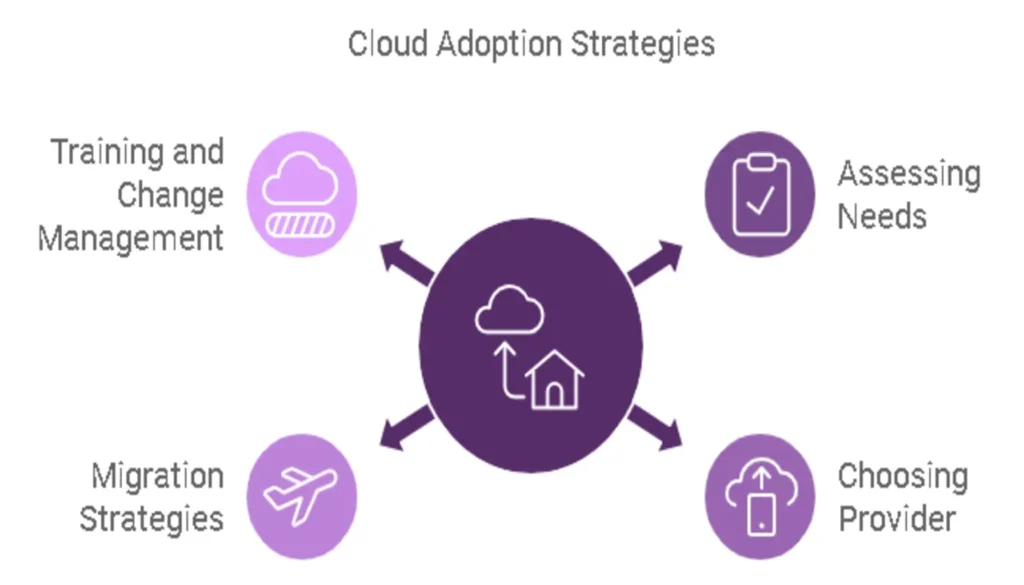
Adopting cloud-based services is a transformative journey that can significantly enhance your organization’s efficiency, scalability, and competitiveness. However, successful implementation requires careful planning, strategic decision-making, and effective change management. In this section, we’ll explore the key steps to implementing cloud-based services in your business, ensuring a smooth transition and maximizing the benefits of cloud computing.
Assessing Your Organization’s Needs
Before diving into cloud adoption, it’s crucial to conduct a thorough assessment of your organization’s needs, current infrastructure, and future goals. This evaluation will help you determine the most appropriate cloud services and deployment models for your business.
- Inventory Current IT Infrastructure:
- Document existing hardware, software, and network resources
- Identify applications and workloads that could benefit from cloud migration
- Define Business Objectives:
- Outline short-term and long-term business goals
- Determine how cloud services can support these objectives
- Identify Pain Points:
- Analyze current IT challenges and bottlenecks
- Consider how cloud solutions could address these issues
- Evaluate Data Sensitivity and Compliance Requirements:
- Assess the types of data your organization handles
- Identify industry-specific regulations and compliance standards (e.g., GDPR, HIPAA)
- Determine Budget and Resources:
- Estimate the total cost of ownership (TCO) for cloud adoption
- Assess the skills and resources available within your organization
To help visualize this assessment process, consider the following interactive decision tree:
Cloud Adoption Decision Tree
Choosing the Right Cloud Service Provider
Selecting the appropriate cloud service provider is a critical decision that will impact your organization’s cloud journey. Consider the following factors when evaluating potential providers:
- Service Offerings: Ensure the provider offers the specific services you need (IaaS, PaaS, SaaS)
- Performance and Reliability: Look for providers with high uptime guarantees and robust performance metrics
- Security and Compliance: Verify that the provider meets your industry’s security standards and compliance requirements
- Scalability: Choose a provider that can easily accommodate your growth
- Cost Structure: Compare pricing models and hidden costs
- Support and Documentation: Evaluate the quality of customer support and available resources
- Integration Capabilities: Ensure compatibility with your existing systems and potential for future integrations
- Vendor Lock-in: Consider the ease of migrating to another provider if needed
To help you compare cloud service providers, here’s a table highlighting key features of the top three providers:
| Feature | Amazon Web Services (AWS) | Microsoft Azure | Google Cloud Platform (GCP) |
| Global Presence | 84 Availability Zones | 60+ regions | 35 regions |
| Key Services | EC2, S3, Lambda | Virtual Machines, Blob Storage, Azure Functions | Compute Engine, Cloud Storage, Cloud Functions |
| Strengths | Market leader, extensive service catalog | Strong integration with Microsoft products | Advanced AI and machine learning capabilities |
| Pricing Model | Pay-as-you-go, reserved instances | Pay-as-you-go, reserved instances | Pay-as-you-go, sustained use discounts |
| Free Tier | 12 months | 12 months | Always free tier for certain services |
For an in-depth comparison of cloud providers, visit Gartner’s Magic Quadrant for Cloud Infrastructure and Platform Services
Migration Strategies and Best Practices
Once you’ve chosen a cloud service provider, it’s time to plan and execute your migration strategy. Here are some key approaches and best practices:
- Rehosting (Lift and Shift):
- Move applications to the cloud without major changes
- Quickest migration method, but may not fully leverage cloud benefits
- Replatforming (Lift, Tinker, and Shift):
- Make minor optimizations to applications during migration
- Balances speed with cloud optimization
- Refactoring/Re-architecting:
- Redesign applications to be cloud-native
- Maximizes cloud benefits but requires more time and resources
- Repurchasing:
- Move to a different product, often involving a shift to SaaS
- Can be efficient for standardized processes like CRM or HR
Best Practices for Cloud Migration:
- Start with non-critical workloads to gain experience
- Implement strong security measures from the outset
- Use automation tools to streamline the migration process
- Continuously monitor and optimize performance post-migration
- Maintain clear communication with stakeholders throughout the process
To visualize the migration process, consider this interactive flowchart:
Cloud Migration Flowchart
– Define migration goals
– Choose migration strategy
– Implement security measures
– Train staff on new processes
– Perform testing and validation
– Address any issues or discrepancies
– Optimize resource allocation
– Implement additional cloud-native features
Training and Change Management
Successful cloud adoption requires more than just technical implementation; it necessitates a shift in organizational culture and processes. Effective training and change management are crucial for ensuring smooth adoption and maximizing the benefits of cloud-based services.
- Develop a Comprehensive Training Program:
- Offer role-specific training for IT staff, developers, and end-users
- Provide hands-on learning opportunities and sandbox environments
- Leverage vendor-provided training resources and certification programs
- Create a Change Management Strategy:
- Communicate the benefits and reasons for cloud adoption clearly
- Address concerns and resistance proactively
- Involve key stakeholders in the decision-making process
- Establish New Processes and Policies:
- Update IT governance policies to align with cloud best practices
- Implement new security protocols for cloud environments
- Develop guidelines for cloud resource management and cost optimization
- Continuous Learning and Improvement:
- Encourage ongoing skill development and certification
- Regularly assess and refine cloud processes
- Stay informed about new cloud technologies and features
To support your change management efforts, consider implementing a Cloud Center of Excellence (CCoE) within your organization. A CCoE can serve as a central hub for cloud expertise, best practices, and governance.
Cloud Center of Excellence (CCoE) Key Responsibilities:
- Develop and maintain cloud strategy and roadmap
- Define and enforce cloud governance policies
- Provide technical guidance and support for cloud initiatives
- Manage cloud vendor relationships
- Drive innovation and best practices adoption
- Monitor and optimize cloud costs
Implementing cloud-based services in your business is a multi-faceted process that requires careful planning, strategic decision-making, and ongoing management. By thoroughly assessing your needs, choosing the right provider, implementing effective migration strategies, and prioritizing training and change management, you can set your organization up for success in the cloud era.
Remember, cloud adoption is an ongoing journey rather than a one-time event. Continuously evaluate your cloud strategy, stay informed about new developments, and be prepared to adapt as your business needs evolve and new cloud technologies emerge.
Cloud Security and Compliance
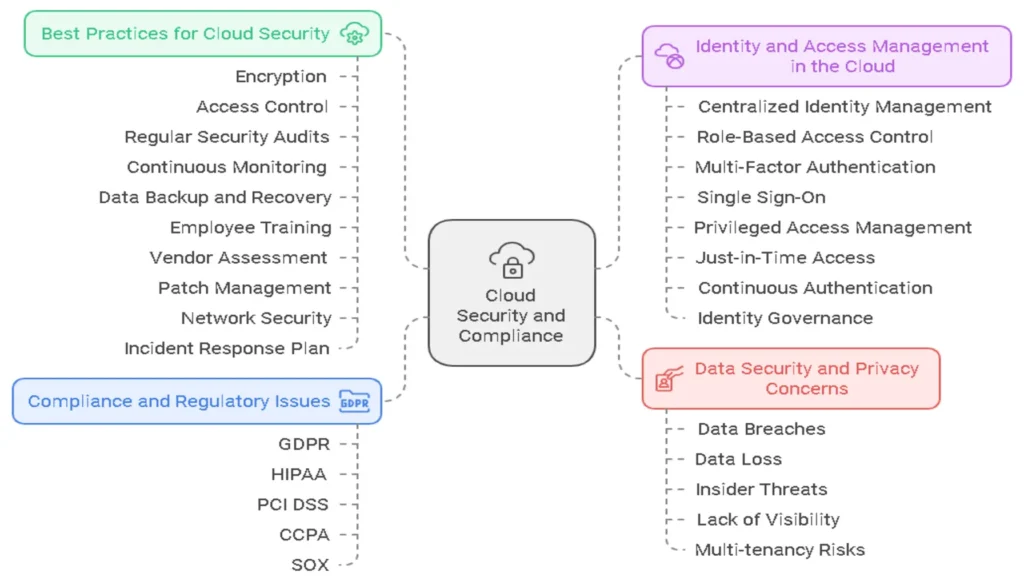
In the era of cloud-based services, security and compliance have becomei paramount concerns for organizations of all sizes. As businesses increasingly rely on cloud infrastructure to store sensitive data and run critical operations, the need for robust security measures and adherence to regulatory standards has never been more crucial. This section delves into the key aspects of cloud security and compliance, exploring the challenges, best practices, and strategies for maintaining a secure and compliant cloud environment.
Data Security and Privacy Concerns
The shift to cloud-based services has introduced new challenges in data security and privacy. While cloud providers offer advanced security features, the shared responsibility model means that organizations must also play an active role in protecting their data. Here are some of the primary concerns:
- Data Breaches: The centralization of data in cloud environments can make them attractive targets for cybercriminals. A single breach can potentially expose vast amounts of sensitive information.
- Data Loss: Accidental deletion, hardware failures, or malicious attacks can lead to data loss if proper backup and recovery mechanisms are not in place.
- Insider Threats: Employees or contractors with access to cloud resources may intentionally or unintentionally compromise data security.
- Lack of Visibility: Organizations may struggle to maintain visibility and control over their data in complex cloud environments.
- Multi-tenancy Risks: In public cloud environments, data from multiple customers may be stored on the same physical infrastructure, raising concerns about data isolation.
To address these concerns, organizations must implement a comprehensive cloud security strategy that includes encryption, access controls, regular security audits, and employee training.
Top Cloud Security Concerns (2024)
Compliance and Regulatory Issues
As cloud-based services handle increasingly sensitive data, compliance with industry regulations and data protection laws has become a critical concern. Some of the key regulatory frameworks that impact cloud security include:
- General Data Protection Regulation (GDPR): This EU regulation sets strict guidelines for the collection, processing, and storage of personal data. Cloud service providers and their customers must ensure GDPR compliance when handling EU citizens’ data.
- Health Insurance Portability and Accountability Act (HIPAA): For organizations in the healthcare sector, HIPAA compliance is mandatory when dealing with protected health information (PHI) in the cloud.
- Payment Card Industry Data Security Standard (PCI DSS): Companies that process credit card transactions must adhere to PCI DSS requirements, even when using cloud-based payment systems.
- California Consumer Privacy Act (CCPA): This regulation grants California residents certain rights over their personal data, impacting how businesses collect and use data in cloud environments.
- Sarbanes-Oxley Act (SOX): Public companies must ensure their cloud-based financial systems comply with SOX requirements for data integrity and financial reporting.
To navigate this complex regulatory landscape, organizations should:
- Conduct regular compliance audits
- Choose cloud providers that offer compliance certifications
- Implement data governance policies
- Maintain detailed documentation of compliance efforts
Best Practices for Cloud Security
Implementing robust security measures is essential for protecting data and maintaining compliance in cloud environments. Here are some best practices for enhancing cloud security:
- Encryption: Implement end-to-end encryption for data in transit and at rest. Use strong encryption algorithms and manage encryption keys securely.
- Access Control: Employ the principle of least privilege, granting users only the minimum access necessary to perform their tasks. Implement multi-factor authentication (MFA) for all user accounts.
- Regular Security Audits: Conduct frequent security assessments and penetration testing to identify vulnerabilities in your cloud infrastructure.
- Continuous Monitoring: Implement real-time monitoring and logging to detect and respond to security incidents promptly.
- Data Backup and Recovery: Maintain regular backups of critical data and test recovery procedures to ensure business continuity in case of data loss or system failures.
- Employee Training: Educate employees about cloud security best practices, including safe data handling and recognizing phishing attempts.
- Vendor Assessment: Thoroughly evaluate the security practices of cloud service providers before entrusting them with your data.
- Patch Management: Keep all systems, applications, and security tools up-to-date with the latest security patches.
- Network Security: Implement virtual private networks (VPNs), firewalls, and intrusion detection/prevention systems to secure network connections to cloud resources.
- Incident Response Plan: Develop and regularly test an incident response plan to ensure rapid and effective action in the event of a security breach.
Cloud Security Implementation Flowchart
Identity and Access Management in the Cloud
Identity and Access Management (IAM) is a crucial component of cloud security, ensuring that only authorized users and systems can access cloud resources. Effective IAM in cloud environments involves:
- Centralized Identity Management: Implement a centralized system for managing user identities across all cloud services and applications.
- Role-Based Access Control (RBAC): Define and enforce access policies based on user roles and responsibilities.
- Multi-Factor Authentication (MFA): Require multiple forms of authentication for accessing sensitive cloud resources.
- Single Sign-On (SSO): Implement SSO to improve user experience and security by reducing the number of credentials users need to manage.
- Privileged Access Management (PAM): Implement strict controls and monitoring for accounts with elevated privileges.
- Just-in-Time (JIT) Access: Grant temporary, time-limited access to resources only when needed.
- Continuous Authentication: Employ technologies that continuously verify user identity throughout a session, not just at login.
- Identity Governance: Regularly review and audit user access rights to ensure they align with current job roles and responsibilities.
By implementing robust IAM practices, organizations can significantly reduce the risk of unauthorized access and data breaches in their cloud environments.
In conclusion, as cloud-based services continue to evolve and expand, so too must our approach to security and compliance. By addressing data security concerns, navigating regulatory requirements, implementing best practices, and maintaining strong identity and access management, organizations can harness the full potential of cloud computing while safeguarding their most valuable assets.
Remember, cloud security is a shared responsibility between cloud providers and their customers, requiring ongoing vigilance, adaptation, and collaboration to stay ahead of emerging threats in the ever-changing digital landscape.
Advanced Cloud Technologies and Trends
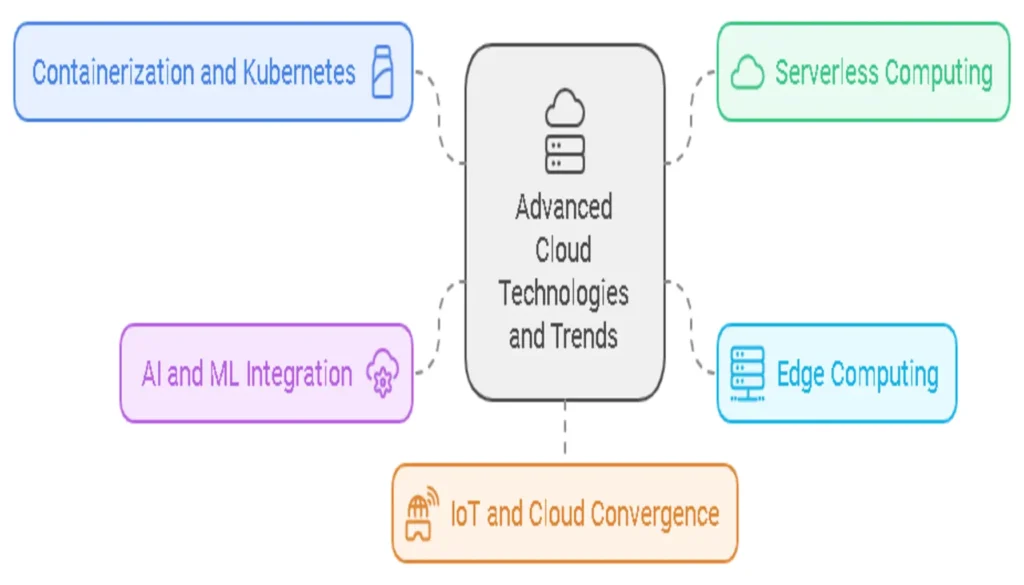
As cloud-based services continue to evolve, several cutting-edge technologies and trends are shaping the future of cloud computing. These innovations are not only enhancing the capabilities of cloud services but also opening up new possibilities for businesses across various sectors. Let’s explore some of the most impactful advanced cloud technologies and trends.
Containerization and Kubernetes
Containerization has revolutionized the way applications are developed, deployed, and managed in cloud environments. Containers package an application and all its dependencies into a single, lightweight unit that can run consistently across different computing environments.
Key benefits of containerization:
- Improved scalability and portability
- Faster deployment and updates
- Efficient resource utilization
- Enhanced isolation and security
Kubernetes, an open-source container orchestration platform, has emerged as the de facto standard for managing containerized applications at scale. It automates the deployment, scaling, and management of containerized applications, providing a robust foundation for cloud-native development.
Kubernetes Architecture Components
Control Plane
The brain of the Kubernetes cluster, responsible for maintaining the desired state of the cluster, making global decisions, and detecting and responding to cluster events.
Nodes
Worker machines that run containerized applications. Each node contains the services necessary to run pods and is managed by the control plane.
Pods
The smallest deployable units in Kubernetes. A pod represents a single instance of a running process in a cluster and can contain one or more containers.
Services
An abstract way to expose an application running on a set of pods as a network service, providing a stable IP address and DNS name for accessing the application.
Serverless Computing
Serverless computing represents a paradigm shift in cloud services, allowing developers to build and run applications without the complexity of managing servers. In a serverless model, the cloud provider automatically manages the infrastructure, scaling resources up or down based on demand.
Key features of serverless computing:
- Auto-scaling: Resources are automatically allocated and deallocated based on application needs.
- Pay-per-use pricing: Users are charged only for the actual compute time used.
- Reduced operational overhead: Developers can focus on writing code rather than managing infrastructure.
- Event-driven architecture: Functions are triggered by specific events, enabling efficient resource utilization.
Popular serverless platforms include AWS Lambda, Azure Functions, and Google Cloud Functions.
Edge Computing and Its Impact
Edge computing brings computation and data storage closer to the devices where it's being gathered, rather than relying on a central location that can be thousands of miles away. This approach is becoming increasingly important as the Internet of Things (IoT) expands and more devices generate data in real-time.
Benefits of edge computing:
- Reduced latency
- Improved data security and privacy
- Bandwidth conservation
- Enhanced reliability in areas with poor connectivity
Edge computing is particularly crucial for applications that require real-time processing, such as autonomous vehicles, industrial IoT, and augmented reality.
Edge Computing vs. Cloud Computing: Latency Comparison
Artificial Intelligence (AI) and Machine Learning (ML) Integration
The integration of AI and ML with cloud-based services is driving innovation across industries. Cloud providers are offering AI and ML services that enable businesses to leverage these technologies without significant upfront investments in hardware and expertise.
Key AI/ML cloud services:
- Machine Learning Platforms: Services like Amazon SageMaker, Google Cloud AI Platform, and Azure Machine Learning provide tools for building, training, and deploying ML models.
- Pre-trained AI Models: Cloud providers offer pre-trained models for common tasks such as image recognition, natural language processing, and speech-to-text conversion.
- AI-powered Analytics: Services that use AI to analyze large datasets and provide actionable insights.
- Conversational AI: Platforms for building chatbots and virtual assistants.
The combination of cloud computing's scalability with AI's analytical power is enabling organizations to process vast amounts of data and derive valuable insights more efficiently than ever before.
Internet of Things (IoT) and Cloud Convergence
The Internet of Things (IoT) and cloud computing are increasingly converging, creating powerful synergies that are transforming industries. Cloud-based IoT platforms provide the infrastructure needed to collect, process, and analyze data from millions of connected devices.
Benefits of IoT-Cloud convergence:
- Scalable data storage and processing
- Advanced analytics and machine learning capabilities
- Remote device management and updates
- Enhanced security features
Major cloud providers offer comprehensive IoT platforms, such as AWS IoT, Azure IoT, and Google Cloud IoT.
IoT-Cloud Convergence: Industry Applications
Smart Manufacturing
Real-time monitoring of production lines, predictive maintenance, and supply chain optimization.
Smart Cities
Traffic management, waste management, and energy-efficient lighting systems.
Healthcare
Remote patient monitoring, medical device data analysis, and personalized treatment plans.
Agriculture
Precision farming, crop monitoring, and automated irrigation systems.
As these advanced technologies continue to evolve and converge, they are creating new opportunities for innovation and disruption across industries. Organizations that can effectively leverage these cloud-based technologies will be well-positioned to drive digital transformation and gain a competitive edge in the rapidly evolving digital landscape.
By embracing containerization, serverless computing, edge computing, AI/ML integration, and IoT-cloud convergence, businesses can unlock new levels of efficiency, scalability, and innovation. As we move forward, the synergies between these technologies will likely lead to even more groundbreaking applications and services, further cementing the central role of cloud-based services in shaping the future of business and technology.
Cloud-Based Services for Specific Industries
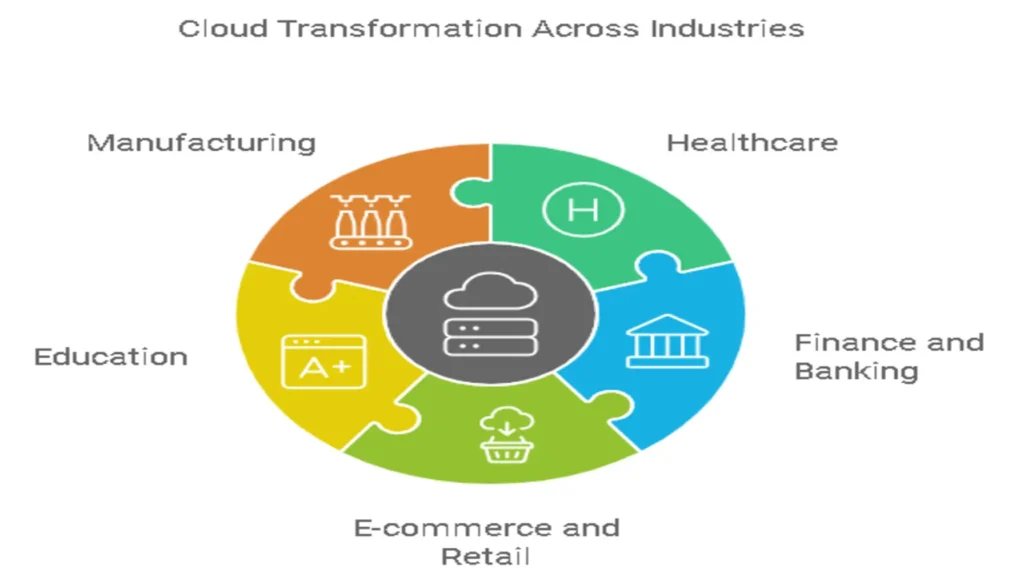
Cloud-based services have revolutionized operations across various industries, offering tailored solutions to address unique challenges and drive innovation. Let's explore how cloud computing is transforming five key sectors: healthcare, finance and banking, e-commerce and retail, education, and manufacturing.
Healthcare
The healthcare industry has embraced cloud-based services to improve patient care, streamline operations, and enhance data management. Here are some key applications:
- Electronic Health Records (EHRs): Cloud-based EHR systems allow healthcare providers to access and update patient information securely from anywhere, improving care coordination and reducing errors.
- Telemedicine: Cloud platforms enable remote consultations, making healthcare more accessible, especially in rural areas.
- Medical Imaging: Cloud storage and processing power facilitate the management and analysis of large medical imaging files, supporting faster diagnoses.
- Drug Discovery: Cloud computing accelerates drug discovery processes through advanced data analytics and machine learning algorithms.
- IoT Integration: Cloud services support the integration of IoT devices for remote patient monitoring and data collection.
According to a report by MarketsandMarkets, the healthcare cloud computing market is expected to reach $64.7 billion by 2025, growing at a CAGR of 18.1% from 2020 to 2025.
Healthcare Cloud Computing Market Growth
Finance and Banking
The finance and banking sector has leveraged cloud-based services to enhance security, improve customer experiences, and streamline operations. Key applications include:
- Mobile Banking: Cloud platforms support secure and scalable mobile banking applications, allowing customers to manage their finances on-the-go.
- Fraud Detection: Advanced analytics and machine learning algorithms powered by cloud computing help detect and prevent fraudulent activities in real-time.
- Risk Management: Cloud-based risk assessment tools enable financial institutions to analyze vast amounts of data for better decision-making.
- Regulatory Compliance: Cloud services facilitate the storage and analysis of data required for regulatory reporting and compliance.
- Blockchain Integration: Cloud platforms support the implementation of blockchain technology for secure and transparent transactions.
A report by Accenture found that 95% of banks have a cloud strategy in place, with 50% of their workloads expected to be in the cloud by 2023.
E-commerce and Retail
Cloud-based services have transformed the e-commerce and retail landscape, enabling businesses to provide personalized shopping experiences and manage operations efficiently:
- Scalable Websites: Cloud hosting ensures e-commerce platforms can handle traffic spikes during peak shopping periods.
- Inventory Management: Cloud-based inventory systems provide real-time stock updates across multiple channels.
- Personalized Recommendations: Cloud-powered AI and machine learning algorithms analyze customer data to offer personalized product recommendations.
- Omnichannel Integration: Cloud services facilitate seamless integration between online and offline retail channels.
- Supply Chain Optimization: Cloud-based analytics help retailers optimize their supply chain and logistics operations.
According to Grand View Research, the global retail cloud market size is expected to reach $82.4 billion by 2028, growing at a CAGR of 18.7% from 2021 to 2028.
Cloud Adoption in Retail: Key Benefits
| Benefit | Description |
|---|---|
| Scalability | Easily handle traffic spikes during peak shopping seasons |
| Cost Efficiency | Reduce IT infrastructure costs and pay only for resources used |
| Data Analytics | Gain valuable insights from customer data for personalized marketing |
| Inventory Management | Real-time stock updates across multiple channels |
| Omnichannel Integration | Seamless integration between online and offline retail channels |
Education
The education sector has embraced cloud-based services to enhance learning experiences, improve collaboration, and streamline administrative tasks:
- Learning Management Systems (LMS): Cloud-based LMS platforms enable institutions to deliver online courses and manage student progress effectively.
- Virtual Classrooms: Cloud services support real-time video conferencing and collaboration tools for remote learning.
- Digital Content Delivery: Cloud storage and content delivery networks ensure seamless access to educational resources.
- Student Information Systems: Cloud-based systems streamline the management of student data, admissions, and academic records.
- Research Collaboration: Cloud platforms facilitate collaboration among researchers across institutions and countries.
A report by MarketsandMarkets projects that the global education cloud computing market will grow from $8.4 billion in 2020 to $19.9 billion by 2025, at a CAGR of 18.8%.
Manufacturing
Cloud-based services are driving the fourth industrial revolution (Industry 4.0) in manufacturing, enabling smart factories and optimized production processes:
- Internet of Things (IoT) Integration: Cloud platforms support the integration and analysis of data from IoT sensors on manufacturing equipment.
- Predictive Maintenance: Cloud-powered analytics help predict equipment failures, reducing downtime and maintenance costs.
- Supply Chain Management: Cloud-based solutions provide real-time visibility into supply chain operations, improving efficiency and reducing costs.
- Product Lifecycle Management (PLM): Cloud PLM systems streamline product development processes and collaboration among teams.
- Digital Twins: Cloud computing enables the creation and management of digital twins for product and process optimization.
According to a report by Grand View Research, the global cloud manufacturing market size is expected to reach $111.9 billion by 2028, growing at a CAGR of 16.3% from 2021 to 2028.
In conclusion, cloud-based services are transforming industries across the board, offering tailored solutions to address sector-specific challenges. From improving patient care in healthcare to enabling smart factories in manufacturing, the cloud is driving innovation and efficiency in diverse fields. As technology continues to evolve, we can expect even more sophisticated cloud-based solutions to emerge, further revolutionizing these industries and opening new possibilities for growth and innovation.
Optimizing Cloud-Based Services for Maximum Efficiency
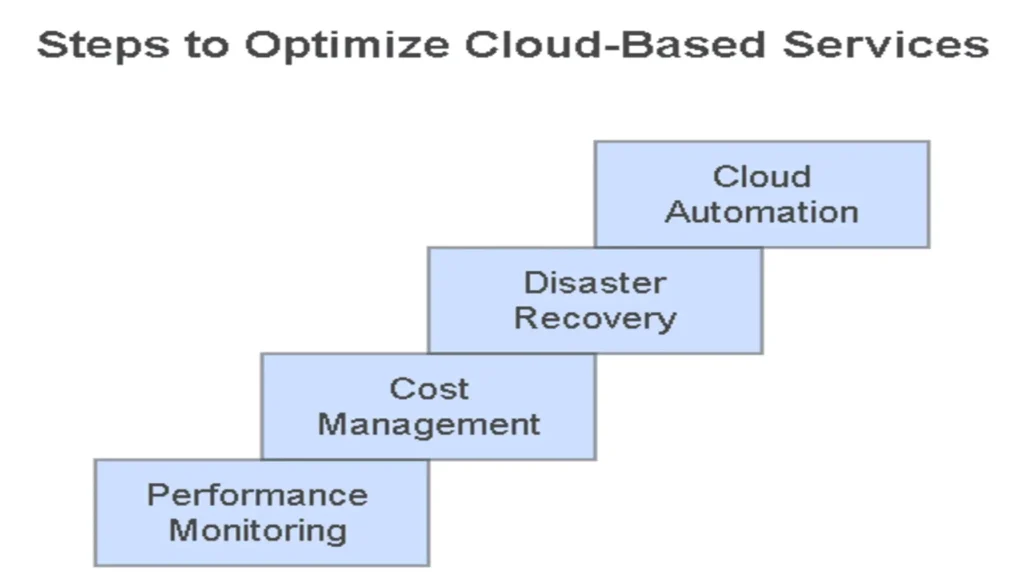
As businesses increasingly rely on cloud-based services, optimizing these resources becomes crucial for achieving maximum efficiency, cost-effectiveness, and resilience. In this section, we'll explore key strategies to enhance your cloud infrastructure's performance, manage costs, ensure business continuity, and leverage automation for streamlined operations.
Performance Monitoring and Optimization
Effective performance monitoring and optimization are essential for maintaining the health and efficiency of your cloud-based services. By implementing robust monitoring practices, you can identify bottlenecks, predict potential issues, and optimize resource allocation.
Key Performance Indicators (KPIs)
To effectively monitor your cloud infrastructure, focus on these critical KPIs:
- CPU Utilization: Measures the percentage of CPU capacity being used.
- Memory Usage: Tracks the amount of RAM being consumed.
- Disk I/O: Monitors read and write operations on storage devices.
- Network Throughput: Measures the rate of data transfer across the network.
- Response Time: Tracks the time taken for a system to respond to a request.
- Error Rates: Monitors the frequency of errors occurring in your applications.
Monitoring Tools
Leverage cloud-native and third-party monitoring tools to gain insights into your infrastructure's performance:
- AWS CloudWatch: Provides monitoring for AWS resources and applications.
- Azure Monitor: Offers comprehensive monitoring for Azure services.
- Google Cloud Monitoring: Delivers monitoring, logging, and diagnostics for GCP.
- Datadog: Offers multi-cloud monitoring and analytics.
- New Relic: Provides full-stack observability for cloud environments.
Performance Optimization Techniques
Implement these strategies to enhance your cloud infrastructure's performance:
- Right-sizing: Adjust resource allocation to match actual usage patterns.
- Caching: Implement caching mechanisms to reduce database load and improve response times.
- Content Delivery Networks (CDNs): Use CDNs to distribute content globally and reduce latency.
- Database Optimization: Fine-tune database queries and indexing for improved performance.
- Auto-scaling: Implement auto-scaling policies to dynamically adjust resources based on demand.
Cloud Performance Optimization Impact
Cost Management Strategies
Effective cost management is crucial for maximizing the value of your cloud investments. Implement these strategies to optimize your cloud spending:
- Resource Optimization
- Identify and eliminate idle resources
- Right-size instances based on actual usage
- Leverage spot instances for non-critical workloads
- Reserved Instances and Savings Plans
- Utilize reserved instances for predictable workloads
- Implement savings plans for long-term cost savings
- Cost Allocation and Tagging
- Implement a comprehensive tagging strategy
- Use cost allocation tags to track spending by department or project
- Budget Alerts and Cost Anomaly Detection
- Set up budget alerts to prevent overspending
- Implement cost anomaly detection to identify unexpected spikes in usage
- Multi-Cloud and Hybrid Cloud Strategies
- Leverage multiple cloud providers to optimize costs
- Implement a hybrid cloud approach for cost-effective resource allocation
For a detailed guide on cloud cost optimization, check out this comprehensive resource from AWS on Cost Optimization.
Disaster Recovery and Business Continuity Planning
Ensuring business continuity and implementing robust disaster recovery strategies are critical for maintaining the reliability and availability of your cloud-based services.
- Disaster Recovery Strategies
- Backup and Restore: Regularly back up data and configurations
- Pilot Light: Maintain a minimal version of the environment ready to scale up
- Warm Standby: Keep a scaled-down but fully functional copy of the production environment
- Multi-Site: Run workloads simultaneously in multiple regions
- RPO (Recovery Point Objective) and RTO (Recovery Time Objective)
- Define acceptable data loss (RPO) and downtime (RTO) for each application
- Implement strategies to meet or exceed these objectives
- Data Replication and Synchronization
- Implement real-time data replication across regions
- Use database synchronization technologies for consistent data across sites
- Regular Testing and Drills
- Conduct regular disaster recovery drills
- Test failover and failback processes to ensure effectiveness
For more insights on disaster recovery best practices, refer to Microsoft's Azure Site Recovery documentation.
Cloud Automation and Orchestration
Leveraging automation and orchestration tools can significantly enhance the efficiency and reliability of your cloud-based services.
- Infrastructure as Code (IaC)
- Use tools like Terraform, AWS CloudFormation, or Azure Resource Manager templates
- Version control your infrastructure definitions
- Implement CI/CD pipelines for infrastructure changes
- Configuration Management
- Utilize tools like Ansible, Chef, or Puppet for consistent configuration management
- Implement policy-as-code for compliance and security
- Automated Scaling and Self-Healing
- Implement auto-scaling policies based on performance metrics
- Use health checks and automated remediation for self-healing capabilities
- Workflow Orchestration
- Leverage tools like Apache Airflow or AWS Step Functions for complex workflow orchestration
- Automate routine operational tasks and processes
- AI-Driven Optimization
- Implement AI and machine learning models for predictive scaling and resource optimization
- Use AI-powered anomaly detection for proactive issue resolution
By implementing these optimization strategies, businesses can significantly enhance the performance, cost-effectiveness, and reliability of their cloud-based services. Remember, optimization is an ongoing process that requires continuous monitoring, analysis, and refinement to adapt to changing business needs and technological advancements.
The Future of Cloud-Based Services
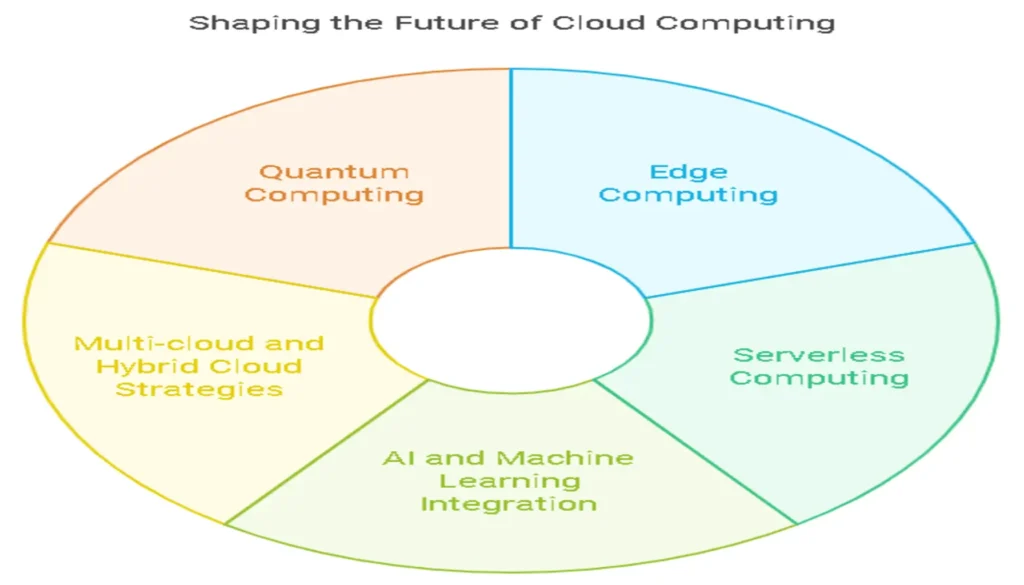
As cloud-based services continue to evolve at a breakneck pace, understanding emerging trends and future predictions is crucial for businesses looking to stay ahead of the curve. In this section, we'll explore the cutting-edge developments shaping the future of cloud computing and their potential impact on digital transformation.
Emerging Trends and Technologies
The cloud computing landscape is constantly shifting, with new technologies and approaches emerging to address evolving business needs. Here are some of the most significant trends shaping the future of cloud-based services:
Edge Computing
As the Internet of Things (IoT) expands, edge computing is becoming increasingly important. This trend brings computation and data storage closer to the sources of data, reducing latency and improving real-time processing capabilities.
Serverless Computing
Also known as Function as a Service (FaaS), serverless computing allows developers to build and run applications without managing the underlying infrastructure. This trend is gaining traction due to its cost-efficiency and scalability.
AI and Machine Learning Integration
Cloud providers are increasingly incorporating AI and ML capabilities into their offerings, making these advanced technologies more accessible to businesses of all sizes.
Multi-cloud and Hybrid Cloud Strategies
Organizations are adopting multi-cloud and hybrid cloud approaches to optimize performance, reduce costs, and avoid vendor lock-in.
Quantum Computing
While still in its early stages, quantum computing has the potential to revolutionize cloud-based services by solving complex problems at unprecedented speeds.
Adoption Rate of Emerging Cloud Technologies
Predictions for Cloud Computing
As we look to the future, several key predictions emerge for the cloud computing industry:
- Exponential Growth: Gartner predicts that by 2025, over 95% of new digital workloads will be deployed on cloud-native platforms, up from 30% in 2021.
- Increased Focus on Security: With the rise of cyber threats, cloud providers will continue to enhance their security measures. Zero-trust security models and advanced encryption techniques will become standard.
- Sustainability Initiatives: Cloud providers will increasingly focus on sustainability, with many aiming for carbon-neutral or carbon-negative operations by 2030.
- Democratization of AI: Cloud-based AI services will make advanced machine learning capabilities accessible to a broader range of businesses, driving innovation across industries.
- Edge-Cloud Convergence: The line between edge computing and cloud computing will blur, creating a seamless continuum of computing resources from the edge to the core.
The Role of Cloud-Based Services in Digital Transformation
Cloud-based services are at the heart of digital transformation, enabling businesses to innovate, scale, and adapt to rapidly changing market conditions. Here's how cloud computing is driving digital transformation across industries:
- Agility and Innovation: Cloud services allow businesses to quickly experiment with new ideas and bring products to market faster. This agility is crucial in today's fast-paced business environment.
- Data-Driven Decision Making: Cloud-based analytics and AI services enable organizations to derive actionable insights from vast amounts of data, leading to more informed decision-making.
- Enhanced Customer Experiences: Cloud technologies power personalized, omnichannel customer experiences, helping businesses meet evolving consumer expectations.
- Operational Efficiency: By automating routine tasks and streamlining processes, cloud-based services help organizations optimize their operations and reduce costs.
- Workforce Transformation: Cloud-based collaboration tools and remote work capabilities are reshaping the modern workplace, enabling distributed teams and flexible work arrangements.
Impact of Cloud-Based Services on Digital Transformation
As we look to the future, it's clear that cloud-based services will continue to play a pivotal role in shaping the digital landscape. Organizations that embrace these technologies and adapt to emerging trends will be well-positioned to thrive in an increasingly digital world.
The cloud is not just about technology. It's about transformation. It's about reimagining what's possible for your business and your customers.
Satya Nadella, CEO of Microsoft
To stay competitive in this rapidly evolving landscape, businesses must continually assess their cloud strategies, embrace emerging technologies, and leverage the full potential of cloud-based services to drive innovation and growth.
Case Studies: Successful Cloud-Based Service Implementation
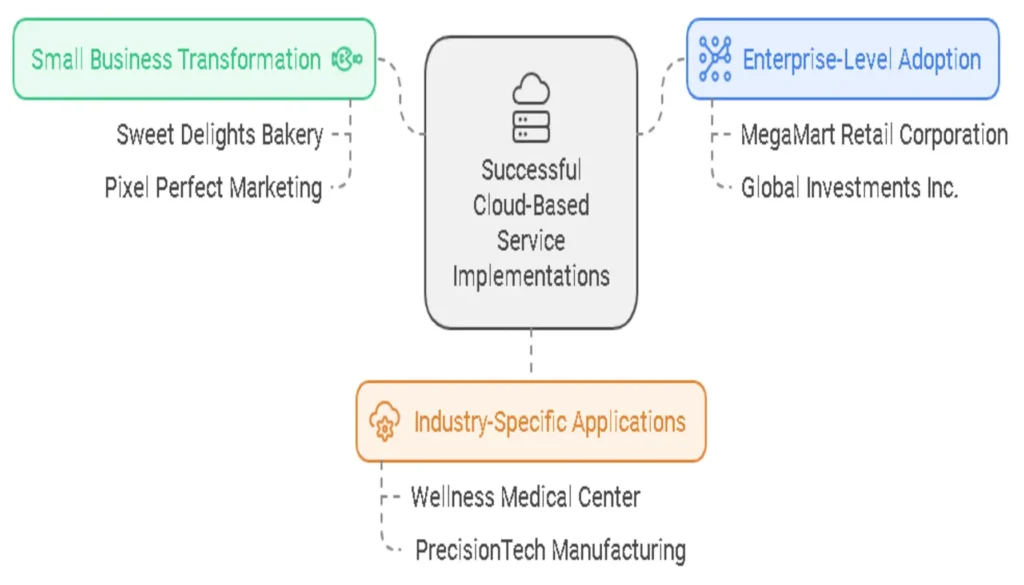
In this section, we'll explore real-world examples of how organizations, ranging from small businesses to large enterprises, have successfully leveraged cloud-based services to transform their operations, drive growth, and gain a competitive edge. These case studies will provide valuable insights into the practical applications of cloud technologies across various industries and scales of operation.
Small Business Transformation
Small businesses often face unique challenges when it comes to technology adoption, including limited resources and expertise. However, cloud-based services have leveled the playing field, allowing smaller companies to access enterprise-grade tools and capabilities. Let's examine how two small businesses harnessed the power of the cloud to revolutionize their operations.
Case Study: Artisanal Bakery Scales Operations with Cloud-Based POS
Company: Sweet Delights Bakery Challenge: Managing inventory, sales, and customer data across multiple locationsSolution: Adoption of a cloud-based Point of Sale (POS) system
Sweet Delights Bakery, a family-owned business with three locations in Portland, Oregon, struggled to manage its growing operations efficiently. The bakery implemented a cloud-based POS system, which provided the following benefits:
- Real-time inventory tracking across all locations
- Centralized customer data management
- Cloud-based analytics for sales trends and forecasting
- Mobile access for owners and managers
Results:
- 30% reduction in inventory waste
- 25% increase in customer retention through targeted marketing
- 15% boost in overall sales within the first year of implementation
Sweet Delights Bakery: Cloud POS Impact
Case Study: Digital Marketing Agency Embraces Cloud Collaboration
Company: Pixel Perfect Marketing Challenge: Streamlining project management and client collaboration Solution: Implementation of cloud-based project management and file sharing tools
Pixel Perfect Marketing, a boutique digital agency with a team of 15, faced difficulties in managing multiple client projects and fostering collaboration among remote team members. The agency adopted a suite of cloud-based tools, including:
- Asana for project management
- Google Workspace for document collaboration and email
- Dropbox for file storage and sharing
Results:
- 40% improvement in project delivery times
- 50% reduction in internal email communication
- 20% increase in client satisfaction scores
Enterprise-Level Adoption
Large enterprises often have complex IT infrastructures and face unique challenges when transitioning to the cloud. However, the benefits of cloud adoption at this scale can be transformative. Let's examine two cases of successful enterprise-level cloud implementations.
Case Study: Global Retailer Modernizes IT Infrastructure
Company: MegaMart Retail Corporation Challenge: Outdated on-premises infrastructure struggling to handle peak shopping seasons Solution: Migration to a hybrid cloud architecture
MegaMart, a Fortune 500 retailer with over 1,000 stores worldwide, faced frequent outages and slow performance during high-traffic periods like Black Friday. The company partnered with Microsoft Azure (dofollow) to implement a hybrid cloud solution, which included:
- Migration of e-commerce platform to Azure Cloud
- Implementation of Azure Kubernetes Service for scalable container orchestration
- Adoption of Azure CDN for improved content delivery
Results:
- 99.99% uptime during peak shopping seasons
- 60% reduction in infrastructure costs
- 3x improvement in website load times
Case Study: Financial Services Firm Enhances Data Analytics Capabilities
Company: Global Investments Inc. Challenge: Processing and analyzing vast amounts of financial data for insightsSolution: Implementation of a cloud-based big data analytics platform
Global Investments Inc., a multinational financial services firm, struggled to extract timely insights from its massive datasets. The company adopted Google Cloud Platform (dofollow) for its big data needs, implementing:
- BigQuery for large-scale data analytics
- Cloud Dataflow for real-time data processing
- Cloud Machine Learning Engine for predictive modeling
Results:
- 75% reduction in time-to-insight for complex financial analyses
- 40% increase in the accuracy of risk assessment models
- $10 million annual savings in infrastructure and operational costs
Industry-Specific Applications
Cloud-based services have found unique applications across various industries, addressing sector-specific challenges and driving innovation. Let's explore two examples of how cloud technologies have been leveraged in healthcare and manufacturing.
Case Study: Healthcare Provider Improves Patient Care with Cloud-Based EHR
Company: Wellness Medical Center Challenge: Inefficient paper-based record-keeping and limited access to patient dataSolution: Implementation of a cloud-based Electronic Health Record (EHR) system
Wellness Medical Center, a multi-specialty clinic with five locations, transitioned from paper records to a cloud-based EHR system. The implementation included:
- Centralized patient records accessible from any location
- Integration with lab systems for automated test result updates
- Secure patient portal for appointment scheduling and communication
Results:
- 35% reduction in administrative tasks
- 50% decrease in medication errors
- 20% improvement in patient satisfaction scores
Case Study: Manufacturer Optimizes Operations with IoT and Cloud
Company: PrecisionTech Manufacturing Challenge: Lack of real-time visibility into production processes and equipment performance Solution: Implementation of an IoT-enabled cloud platform for manufacturing intelligence
PrecisionTech Manufacturing, a mid-sized manufacturer of precision components, implemented an Industrial Internet of Things (IIoT) solution integrated with a cloud-based analytics platform. The solution included:
- Sensors on key equipment to collect real-time data
- AWS IoT Core (dofollow) for device connectivity and data ingestion
- AWS QuickSight for data visualization and analytics
Results:
- 25% increase in overall equipment effectiveness (OEE)
- 30% reduction in unplanned downtime
- 15% improvement in product quality
Cloud-Based Services Impact Across Industries
| Industry | Company | Solution | Key Impact |
|---|---|---|---|
| Retail | Sweet Delights Bakery | Cloud-based POS | 30% reduction in inventory waste |
| Marketing | Pixel Perfect Marketing | Cloud collaboration tools | 40% improvement in project delivery times |
| Retail (Enterprise) | MegaMart Retail Corporation | Hybrid cloud architecture | 60% reduction in infrastructure costs |
| Financial Services | Global Investments Inc. | Cloud-based big data analytics | 75% reduction in time-to-insight |
| Healthcare | Wellness Medical Center | Cloud-based EHR | 50% decrease in medication errors |
| Manufacturing | PrecisionTech Manufacturing | IoT-enabled cloud platform | 25% increase in overall equipment effectiveness |
These case studies demonstrate the versatility and transformative power of cloud-based services across various industries and scales of operation. From small businesses gaining access to enterprise-grade tools to large corporations revolutionizing their IT infrastructure, the cloud has proven to be a catalyst for innovation and efficiency.
Key takeaways from these successful implementations include:
- Scalability: Cloud services allow businesses of all sizes to scale their operations efficiently.
- Cost Efficiency: Many organizations reported significant cost savings after migrating to the cloud.
- Improved Collaboration: Cloud-based tools enhance team collaboration, especially for remote and distributed workforces.
- Data-Driven Insights: Cloud platforms enable advanced analytics and machine learning capabilities, driving better decision-making.
- Industry-Specific Solutions: Cloud services can be tailored to address unique challenges in various sectors.
As cloud technologies continue to evolve, we can expect to see even more innovative applications and transformative implementations across industries. Organizations that embrace cloud-based services and develop strategies for effective adoption will be well-positioned to thrive in the digital era.
Conclusion: Embracing the Cloud-Based Future
As we reach the culmination of our comprehensive exploration of cloud-based services, it's evident that this transformative technology has become an indispensable part of the modern business landscape. The journey through the intricacies of cloud computing has revealed a world of opportunities, challenges, and innovations that continue to shape the way organizations operate in the digital age.
Recap of key benefits and considerations
Let's revisit the primary advantages that cloud-based services offer to businesses of all sizes:
- Cost-effectiveness: By eliminating the need for substantial upfront investments in hardware and reducing ongoing maintenance costs, cloud services provide a more economical IT solution.
- Scalability: The ability to rapidly scale resources up or down based on demand allows businesses to remain agile and responsive to market changes.
- Accessibility: Cloud-based services enable remote work and collaboration, a feature that has become increasingly critical in today's global business environment.
- Innovation: Access to cutting-edge technologies like AI, machine learning, and big data analytics empowers businesses to stay at the forefront of innovation.
- Disaster recovery: Robust backup and recovery solutions offered by cloud providers ensure business continuity in the face of unforeseen events.
However, it's crucial to consider potential challenges:
- Security concerns: While cloud providers invest heavily in security, businesses must remain vigilant and implement additional measures to protect sensitive data.
- Compliance issues: Certain industries may face regulatory challenges when adopting cloud solutions, necessitating careful planning and provider selection.
- Vendor lock-in: Dependency on a single cloud provider can make it difficult to switch services or migrate data in the future.
Benefits vs. Considerations of Cloud-Based Services
Benefits
Cost-effectiveness
Reduced upfront and maintenance costs
Scalability
Flexible resource allocation
Accessibility
Remote work and collaboration
Innovation
Access to cutting-edge technologies
Disaster recovery
Robust backup and recovery solutions
Considerations
Security concerns
Need for additional security measures
Compliance issues
Regulatory challenges in certain industries
Vendor lock-in
Potential difficulty in switching providers
Internet dependency
Reliance on stable internet connections
Data sovereignty
Concerns about data storage locations
The importance of cloud-based services in modern business
The significance of cloud-based services in today's business world cannot be overstated. As organizations continue to navigate the complexities of digital transformation, cloud computing has emerged as a critical enabler of success. Here's why cloud-based services are indispensable for modern businesses:
- Competitive advantage: Cloud adoption allows businesses to leverage advanced technologies and stay ahead of the curve, fostering innovation and agility.
- Global reach: Cloud services facilitate seamless expansion into new markets and enable businesses to serve customers worldwide without significant infrastructure investments.
- Data-driven decision making: The cloud's ability to process and analyze vast amounts of data empowers organizations to make informed, data-driven decisions.
- Enhanced collaboration: Cloud-based tools and platforms break down silos, enabling teams to collaborate effectively regardless of their physical location.
- Sustainability: Cloud computing can contribute to reduced energy consumption and carbon footprint compared to traditional on-premises data centers.
According to a recent study by Flexera, 94% of enterprises use cloud services, with 91% having adopted a multi-cloud strategy. These statistics underscore the pervasive nature of cloud-based services in the modern business landscape.
Encouragement for businesses to explore cloud solutions
As we stand on the cusp of a new era in technology, the message is clear: embracing cloud-based services is no longer optional for businesses that wish to thrive in the digital age. Whether you're a startup looking to scale rapidly or an established enterprise seeking to modernize your operations, the cloud offers a pathway to innovation, efficiency, and growth.
To businesses yet to embark on their cloud journey, consider these steps:
- Start small: Begin with non-critical workloads to gain experience and build confidence in cloud technologies.
- Educate your team: Invest in training and upskilling to ensure your workforce is cloud-ready.
- Partner wisely: Choose cloud providers that align with your business goals and offer robust support.
- Prioritize security: Implement a comprehensive cloud security strategy from the outset.
- Stay informed: Keep abreast of emerging cloud trends and technologies to capitalize on new opportunities.
Remember, the cloud is not just a technology shift; it's a paradigm change in how businesses operate, innovate, and create value. As Satya Nadella, CEO of Microsoft, aptly put it:
"The cloud is not just about efficiency; it's the most transformative technology shift of our time."
In conclusion, cloud-based services have revolutionized the business landscape, offering unparalleled opportunities for growth, innovation, and efficiency. As we look to the future, it's clear that the cloud will continue to play a pivotal role in shaping the next generation of business technologies and practices. The question is no longer whether to adopt cloud services, but how to leverage them most effectively to drive your organization forward.
By embracing cloud-based services, businesses can position themselves at the forefront of innovation, ready to tackle the challenges and seize the opportunities of tomorrow's digital world. The cloud journey may seem daunting, but with the right strategy, partners, and mindset, it's a journey that promises transformative rewards. As we close this exploration of cloud-based services, we encourage you to take the first step – or the next step – in your cloud adoption journey. The future is in the cloud, and it's time for your business to soar.
Frequently Asked Questions About Cloud-Based Services
As cloud-based services continue to reshape the business landscape, many questions arise about their implementation, security, and overall impact. In this section, we'll address some of the most common queries to help you better understand the intricacies of cloud computing.
The main cloud-based services can be categorized into three types:
- Software as a Service (SaaS): Provides access to software applications over the internet. Examples include Salesforce, Google Workspace, and Microsoft 365.
- Platform as a Service (PaaS): Offers a platform for developers to build, run, and manage applications without the complexity of maintaining the underlying infrastructure. Examples include Google App Engine and Heroku.
- Infrastructure as a Service (IaaS): Provides virtualized computing resources over the internet. Examples include Amazon EC2, Microsoft Azure VMs, and Google Compute Engine.
The key difference lies in the level of control and management required from the user. SaaS offers the least control but is the easiest to use, while IaaS provides the most control but requires more management from the user.
Cloud-based services have made significant strides in security over the years. Many cloud providers now offer robust security measures that often surpass those of traditional on-premises systems. However, security in the cloud is a shared responsibility between the provider and the user.
Cloud providers typically employ:
- Advanced encryption for data in transit and at rest
- Multi-factor authentication
- Regular security audits and compliance certifications
- Distributed Denial of Service (DDoS) protection
- 24/7 monitoring and incident response teams
Users must also play their part by implementing proper access controls, regularly updating passwords, and following security best practices. It's crucial to choose a reputable provider and understand their security measures and your responsibilities in the shared security model.
For more information on cloud security best practices, visit the Center for Internet Security's Cloud Companion Guide.
Absolutely! Cloud-based services offer numerous benefits for small businesses, including:
- Cost-effectiveness: Pay-as-you-go models reduce upfront capital expenditure.
- Scalability: Easily adjust resources based on business needs.
- Access to enterprise-grade technology: Leverage sophisticated tools without hefty investments.
- Improved collaboration: Enable remote work and real-time collaboration.
- Automatic updates: Always have access to the latest features and security patches.
A study by Deloitte found that small businesses using cloud technology grow 26% faster and deliver 21% higher gross profits [source].
Selecting the right cloud service provider is crucial for the success of your cloud strategy. Consider the following factors:
- Reliability and performance: Check uptime guarantees and service level agreements (SLAs).
- Security and compliance: Ensure the provider meets your industry's regulatory requirements.
- Scalability: Verify that the provider can accommodate your growth.
- Cost structure: Understand pricing models and potential hidden costs.
- Support and documentation: Evaluate the quality and availability of customer support.
- Integration capabilities: Check compatibility with your existing systems and applications.
- Data portability: Ensure you can easily move your data if you decide to switch providers.
- Geographic availability: Consider data residency requirements and global availability.
It's recommended to start with a thorough assessment of your business needs and compare multiple providers before making a decision.
Transitioning to cloud-based services requires careful planning and execution. Follow these steps for a smooth migration:
- Assess your current infrastructure and applications
- Develop a comprehensive cloud strategy
- Choose the right cloud service model and provider
- Plan your data migration
- Implement robust security measures
- Train your staff on new systems and procedures
- Start with a pilot project before full-scale migration
- Monitor performance and optimize as needed
Consider engaging a cloud migration specialist or consultant to guide you through the process, especially for complex migrations.
The main cloud deployment models are:
- Public Cloud: Services are provided by third-party vendors over the public internet. Resources are shared among multiple customers. Examples: AWS, Azure, Google Cloud Platform.
- Private Cloud: Dedicated cloud infrastructure for a single organization. Can be hosted on-premises or by a third-party provider. Offers more control and customization.
- Hybrid Cloud: Combines public and private clouds, allowing data and applications to be shared between them. Offers flexibility and optimizes existing infrastructure.
Here's a comparison table:
| Feature | Public Cloud | Private Cloud | Hybrid Cloud |
|---|---|---|---|
| Cost | Low (pay-as-you-go) | High (initial investment) | Moderate |
| Security | Good | Excellent | Very Good |
| Scalability | Excellent | Limited | Good |
| Control | Limited | High | Moderate |
While cloud-based services offer benefits for many businesses, their suitability depends on various factors:
- Data sensitivity: Highly regulated industries may face challenges with public cloud adoption.
- Internet connectivity: Businesses in areas with unreliable internet may struggle with cloud dependence.
- Legacy systems: Some older applications may not be cloud-compatible.
- Customization needs: Businesses requiring highly specialized solutions might find limitations in standard cloud offerings.
However, with the variety of cloud models available (public, private, hybrid), most businesses can find a cloud solution that fits their needs. It's essential to conduct a thorough assessment of your business requirements and constraints before deciding on cloud adoption.
Cloud computing and traditional on-premises IT differ in several key aspects:
| Aspect | Cloud Computing | On-Premises IT |
|---|---|---|
| Infrastructure | Managed by provider | Managed in-house |
| Cost Model | Operational expense (OpEx) | Capital expense (CapEx) |
| Scalability | Easily scalable | Limited by physical infrastructure |
| Maintenance | Handled by provider | In-house responsibility |
| Access | From anywhere with internet | Often limited to on-site |
| Security | Shared responsibility | Full control and responsibility |
Cloud computing generally offers more flexibility and scalability, while on-premises IT provides more control over the infrastructure.
While cloud-based services offer numerous benefits, there are potential drawbacks to consider:
- Internet dependency: Service disruptions if internet connection is lost.
- Limited control: Less control over underlying infrastructure and potential vendor lock-in.
- Data security concerns: Storing sensitive data off-site may raise security and compliance issues.
- Potential downtime: Reliance on the provider's uptime and availability.
- Cost management: Pay-as-you-go models can lead to unexpected costs if not managed properly.
- Performance issues: Possible latency for certain applications or large data transfers.
- Compliance challenges: Meeting regulatory requirements in certain industries can be complex.
It's crucial to weigh these potential drawbacks against the benefits when considering cloud adoption. Many of these challenges can be mitigated with proper planning and management.
Cloud-based services have significant implications for data privacy and ownership:
- Data location: Your data may be stored in different geographic locations, subject to various laws.
- Data access: Cloud providers may have access to your data for maintenance and support purposes.
- Data ownership: While you own your data, the provider's terms of service may impact how you can use and access it.
- Privacy regulations: Compliance with regulations like GDPR or CCPA becomes more complex in cloud environments.
- Shared responsibility: Both the provider and the customer have roles in ensuring data privacy and security.
To address these concerns:
- Carefully review the provider's terms of service and data privacy policies.
- Implement strong encryption for sensitive data.
- Use access controls and monitor user activities.
- Stay informed about relevant data protection regulations.
- Consider using a hybrid cloud model for sensitive data.
For more information on cloud data privacy, visit the National Cyber Security Centre's guide on cloud security.




